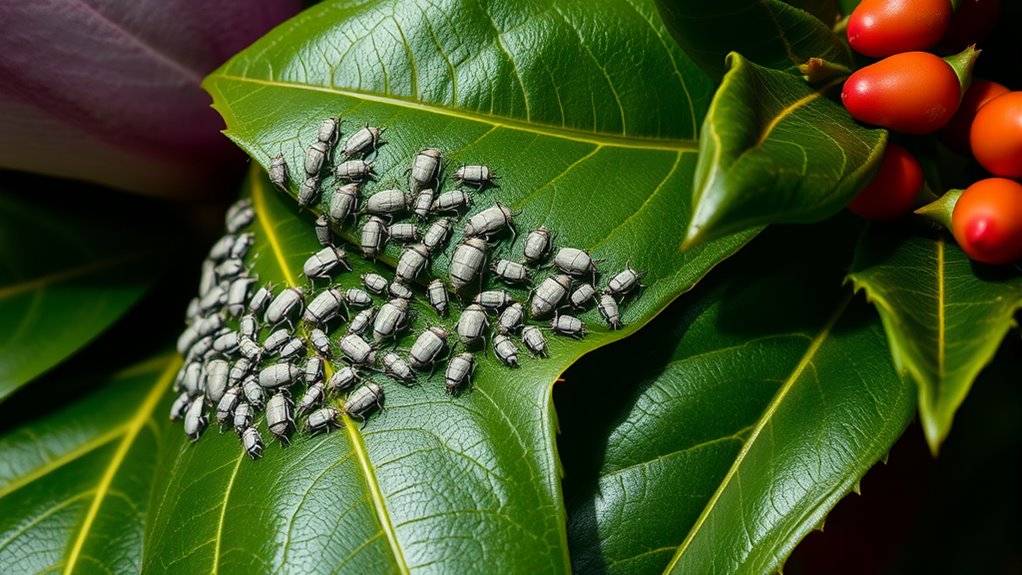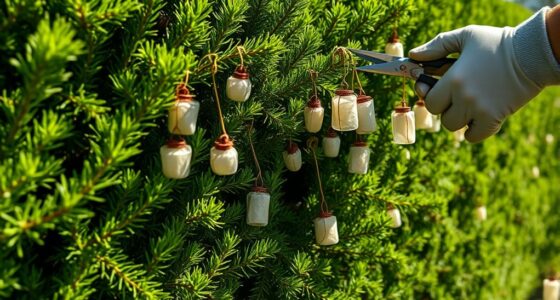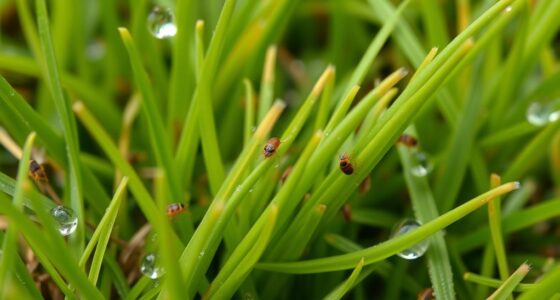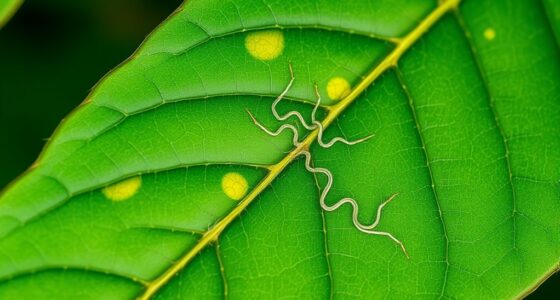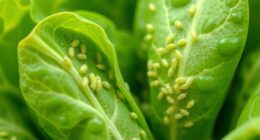Scale insects on magnolia and holly are tiny pests that attach to bark, leaves, and stems, appearing as small bumps. They suck sap, weaken your trees, and leave sticky honeydew or black sooty mold behind. Early detection is key, and you can remove light infestations physically or treat them with horticultural oils and insecticidal soaps. For more effective strategies and signs to watch for, keep exploring these tips to protect your trees.
Key Takeaways
- Scale insects appear as small, oval bumps on magnolia and holly trees, often blending with bark or leaf surfaces.
- They weaken trees over time, causing leaf drop, stunted growth, and potential dieback if untreated.
- Early detection involves inspecting for sticky residue, black mold, or bumps on bark and leaves.
- Effective treatments include physical removal, horticultural oils, or insecticidal soaps during active crawling stages.
- Regular monitoring and prompt action help prevent severe infestations and maintain tree health.

Scale insects are a common problem for magnolia and holly trees, especially during the growing season. These tiny pests attach themselves firmly to the bark, leaves, and stems, making them easy to overlook at first glance. Recognizing an infestation early is crucial, so pest identification becomes your first step. You might notice small, oval-shaped bumps that appear to be part of the tree rather than insects. When disturbed, these scales may stay attached or fall off, revealing the shiny, sticky honeydew underneath. If you see a sticky residue on your trees or black sooty mold growing on the honeydew, it’s a clear sign of scale insect activity. These pests can weaken your trees over time, leading to stunted growth, leaf drop, and even dieback if untreated.
Once you’ve identified the pest, your next move is to plan an effective plant treatment. Since scale insects have a hard shell, they’re resistant to many common insecticides, so you’ll need to choose treatments carefully. For light infestations, physical removal can be effective — gently scraping off the scales with a soft brush or pruning heavily infested branches can reduce their numbers. For more widespread issues, targeted horticultural oils or insecticidal soaps work well because they smother the pests without harming your tree. Applying these treatments during the warmer months, when scales are most active, ensures better results. Make sure to thoroughly coat the affected areas, especially the undersides of leaves and crevices in the bark where scales tend to hide. Additionally, incorporating integrated pest management strategies can enhance your control efforts and reduce chemical reliance.
Regular monitoring is essential for ongoing pest management. After your initial treatment, keep an eye out for new scale crawlers, which can appear after eggs hatch. These tiny nymphs are more vulnerable to treatments, so applying oil or soap sprays at the right time can prevent a reinfestation. If your trees are severely infested, consider consulting a professional arborist for stronger chemical options or integrated pest management strategies. Remember, early detection and prompt plant treatment are your best defenses against scale insects. By combining diligent pest identification with appropriate treatment methods, you can protect your magnolia and holly trees from long-term damage, keeping them healthy and vibrant throughout the growing season.
Frequently Asked Questions
How Can I Prevent Scale Insect Infestations on My Trees?
To prevent scale insect infestations, you should use a combination of biological controls and cultural practices. Regularly inspect your trees and remove heavily infested branches. Encourage natural predators like ladybugs and parasitic wasps to control scales. Additionally, maintain tree health through proper watering, mulching, and fertilizing, which makes trees less vulnerable. Applying insecticidal soap or horticultural oil during early infestation stages also helps keep scale populations low.
Are There Natural Predators for Scale Insects on Magnolia and Holly?
Think of beneficial insects as your garden’s silent guardians. Yes, natural predators like lady beetles, parasitic wasps, and lacewing larvae are ready to wage biological control against scale insects on magnolia and holly. These beneficial insects actively hunt and feed on scale, keeping infestations in check without chemicals. By encouraging their presence, you harness nature’s own army to keep your trees healthy and pest-free.
What Environmental Conditions Favor Scale Insect Outbreaks?
Warm, dry climate factors promote scale insect outbreaks, as they thrive in conditions with limited natural predators and high temperatures. Low soil moisture also weakens plant defenses, making them more vulnerable to infestations. You should monitor your trees during dry spells and hot weather, as these conditions create an ideal environment for scale insects to multiply rapidly. Proper watering and maintaining healthy plants can help reduce the risk of outbreaks.
How Long Does It Take to See Results After Treatment?
You’ll see results within a few weeks after treatment, but patience is crucial—good things come to those who wait. Treatment effectiveness varies, but typically, you should start observing reduced scale insect activity in 2 to 4 weeks. Keep an eye on your plants, and if you don’t notice improvement by then, consider reapplying or trying a different approach. Regular monitoring guarantees your plants stay healthy and pest-free.
Can Scale Insects Spread to Other Nearby Plants?
Yes, scale insects can spread to nearby plants because of their insect mobility. To prevent this, you should consider plant quarantine measures to isolate infested plants. These insects can easily move or be transported via debris or tools, so regularly inspect your garden. Promptly treat infested plants, and maintain good hygiene to minimize the risk of the insects spreading to healthy plants nearby.
Conclusion
Now that you know how to spot and manage scale insects on magnolia and holly, you’re better equipped to protect your plants. Regular inspections and early treatment can keep these pests at bay. Think about your garden as a thriving, healthy space—wouldn’t you want it to stay vibrant and pest-free? With a little effort, you can enjoy lush, beautiful trees without pesky invasions taking over.
